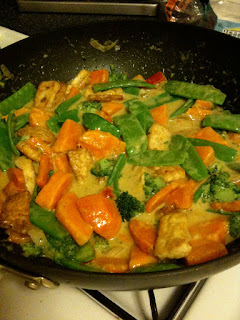Sirloin Tip Roast with Stout Beer
For St. Patrick's Day I wanted to do something a bit different for dinner, but still stay true to the classic pairing of beef, potatoes, and cabbage. Many classic recipes are heavy braised dishes, like corned beef or lamb stew. Due to the surprisingly warm March weather here (50+ F!), my thoughts moved away from a robust, wintery braised dish and began to think of something more spring-like.
Seeing this beautiful sirloin tip roast from North Woods Ranch's Scottish Highland cattle, I immediately decided to keep things simple and prepare a roast beef dinner for St. Pat's. With a cut of beef this great, I'm sure St. Patrick wouldn't mind it coming from Scotch cattle.
The sirloin tip roast is cut from the sirloin, slightly below where sirloin steaks are cut. Just like the steak, this lean roast is perfect for searing and finishing in the dry heat of the oven. Plus, at a weight of about three pounds, it's perfect for a small family and won't take hours to roast.
To begin I salt the roast all over and sear it in an oven-safe skillet greased with butter and olive oil. While the roast is searing on all sides, the oven is preheated to 350 F. After each of the sides of the sirloin have developed a nice brown sear the beef and skillet go into the oven.
Again, the roast will not take very long to roast, so check it after 40 minutes. This roast was pulled out of the oven at 130 F, and then the residual heat brought the temperature up to 135 to finish.
Now, for a bit of an Irish twist, I decided to make pan sauce from the beef drippings using a dark stout. Although Guinness or Murphy's Irish Stout might be more traditional, I wanted to stay local. I chose Buck Snort Stout, brewed by North Country Brewing in Slippery Rock.
To make the pan sauce, I put the skillet from the sirloin back on the stovetop to heat up while the beef rested. Since the stout is very robust I added a tablespoon of cracked black pepper and a sprig of rosemary to the pan for a sharp pop of flavor. Once the drippings from the beef were simmering I poured in half a can of Buck Snort Stout. From here the stout just simmered and reduced with the drippings until it was reduced by half.
Depending on the bitterness of the beer used, a teaspoon or two of dark honey or molasses can even out the sauce if it's a bit too bitter to taste.
To serve, slice the sirloin tip roast thinly and drizzle on a bit of the reduced stout gravy. Serve with your favorite potato and cabbage recipe, plus plenty of good beer. Sláinte!
Recipe at a Glance:
- One Sirloin Tip Roast (3-3.5 lbs)
- 2 tablespoons butter
- 1 tablespoon oil
- Salt and pepper to taste
- 1 can Buck Snort Stout, or your favorite dark beer.
- 1 sprig fresh rosemary
- 1 tablespoon black pepper, coarsely ground or just cracked with a rolling pin
Rub the sirloin roast with salt and pepper on all sides. Preheat the oven to 350 F.
Put the oil and butter in an oven-safe skillet and heat over medium-high heat until the butter foams. Sear the roast on all sides until mahogany brown.
Once the roast is browned on all sides, roast in the oven for 40-60 minutes, depending on desired level of doneness. This roast hit an internal temperature of 135 for medium rare.
Remove roast the roast from the skillet and place on a plate. Cover the roast with foil to keep warm.
While the roast rests, heat the skillet on the stovetop until the beef drippings begin to bubble. Remember to use a towel to handle the oven-heated skillet handle!
Add the rosemary and black pepper to the drippings and cook for a minute to release the aromatic oil from the peppercorns. Pour in half a can (6 oz) of stout beer and stir the pan vigorously to deglaze any browned bits on the bottom of the skillet. Cook for 5-7 minutes until volume reduces by half. Discard rosemary sprig and adjust salt to taste.
Serve stout reduction over sliced beef, or alongside in sauce pot.
Note: Some brands of stout may be on the bitter/hoppy side. If you find your sauce has more bitterness than you like, you can add a small amount of dark honey or molasses to correct the bitterness.
Seeing this beautiful sirloin tip roast from North Woods Ranch's Scottish Highland cattle, I immediately decided to keep things simple and prepare a roast beef dinner for St. Pat's. With a cut of beef this great, I'm sure St. Patrick wouldn't mind it coming from Scotch cattle.
 |
| Scottish Highland Sirloin Tip Roast |
To begin I salt the roast all over and sear it in an oven-safe skillet greased with butter and olive oil. While the roast is searing on all sides, the oven is preheated to 350 F. After each of the sides of the sirloin have developed a nice brown sear the beef and skillet go into the oven.
Again, the roast will not take very long to roast, so check it after 40 minutes. This roast was pulled out of the oven at 130 F, and then the residual heat brought the temperature up to 135 to finish.
 |
| Buck Snort Stout |
Now, for a bit of an Irish twist, I decided to make pan sauce from the beef drippings using a dark stout. Although Guinness or Murphy's Irish Stout might be more traditional, I wanted to stay local. I chose Buck Snort Stout, brewed by North Country Brewing in Slippery Rock.
To make the pan sauce, I put the skillet from the sirloin back on the stovetop to heat up while the beef rested. Since the stout is very robust I added a tablespoon of cracked black pepper and a sprig of rosemary to the pan for a sharp pop of flavor. Once the drippings from the beef were simmering I poured in half a can of Buck Snort Stout. From here the stout just simmered and reduced with the drippings until it was reduced by half.
Depending on the bitterness of the beer used, a teaspoon or two of dark honey or molasses can even out the sauce if it's a bit too bitter to taste.
 |
| In Goes the Buck Snort Stout |
Recipe at a Glance:
- One Sirloin Tip Roast (3-3.5 lbs)
- 2 tablespoons butter
- 1 tablespoon oil
- Salt and pepper to taste
- 1 can Buck Snort Stout, or your favorite dark beer.
- 1 sprig fresh rosemary
- 1 tablespoon black pepper, coarsely ground or just cracked with a rolling pin
Rub the sirloin roast with salt and pepper on all sides. Preheat the oven to 350 F.
Put the oil and butter in an oven-safe skillet and heat over medium-high heat until the butter foams. Sear the roast on all sides until mahogany brown.
Once the roast is browned on all sides, roast in the oven for 40-60 minutes, depending on desired level of doneness. This roast hit an internal temperature of 135 for medium rare.
Remove roast the roast from the skillet and place on a plate. Cover the roast with foil to keep warm.
While the roast rests, heat the skillet on the stovetop until the beef drippings begin to bubble. Remember to use a towel to handle the oven-heated skillet handle!
Add the rosemary and black pepper to the drippings and cook for a minute to release the aromatic oil from the peppercorns. Pour in half a can (6 oz) of stout beer and stir the pan vigorously to deglaze any browned bits on the bottom of the skillet. Cook for 5-7 minutes until volume reduces by half. Discard rosemary sprig and adjust salt to taste.
Serve stout reduction over sliced beef, or alongside in sauce pot.
Note: Some brands of stout may be on the bitter/hoppy side. If you find your sauce has more bitterness than you like, you can add a small amount of dark honey or molasses to correct the bitterness.







Comments
Post a Comment